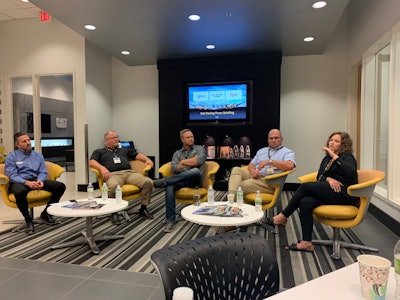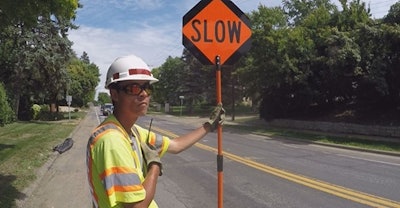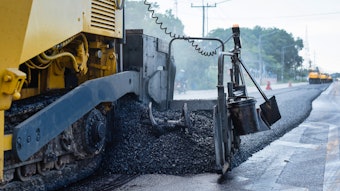
During a Caterpillar Inc. press briefing, four paving contractors spoke to attendees about the issues that keep them up at night. From cultivating a pipeline of good workers to keeping a pipeline of work for their crew, there's no shortage of challenges for business owners today.
1. Labor
Finding and keeping good workers is a consistent issue in every industry right now. Competition for good workers is fierce and the challenge to not only find them, but keep them, is daunting.
The Associated General Contractors of America (AGC) reported in August 2019 that 80% of construction firms are struggling to find workers right now and the panelists agreed.
"Finding a better supply of qualified employees is our number one challenge," Jeff Carlson, president of Park Construction Company out  From L to R: Kevin Adams, Cat Paving Products; Jeff Carlson, Park Construction; Bryce Wuori, Wuori Technology Consulting, Charlie Borene, Park Construction; Mary Katherine Harbin, Maymead, Inc .
From L to R: Kevin Adams, Cat Paving Products; Jeff Carlson, Park Construction; Bryce Wuori, Wuori Technology Consulting, Charlie Borene, Park Construction; Mary Katherine Harbin, Maymead, Inc .
Maymead Inc. out of North Carolina was also struggling to find and keep workers and Mary Katherine Harbin, EEO officer, saw hiring women as an untapped potential for her company.
"Women make up 50% of the population yet we only make up 2% of the employees in the construction industry," Harbin says. "We had been beating our heads against the wall trying to find people and we had not tapped into this group"
Harbin decided to start an all women paving crew at her company to see how it would work.
Read Next: 18 Ways Contractors Can Improve How They Find and Hire Workers
"There is unfortunately a psychological barrier for women to enter a job that they feel is a man’s job," she says. "This is not a man's job, it's a person's job and we just have to find the right people."
Harbin knew that lowering the mental barrier of the job and creating an all women's paving crew would help new hires to feel more comfortable learning this new skill.
"Whenever I interview someone, I try to make the job sound as awful as possible," Harbin jokes. "The reality is the job is hot, physically demanding and we work long hours. It doesn’t matter how you frame it, it takes work ethic, commitment and determination to do what we do and women can, and are, doing it just as well as the men. We want to teach them that."
2. Technology
Like it or not, technology that helps paving contractors do their job better is here to stay. It's whether or not you're adopting it that's going to set you apart from your competition.
"Technology is a big part of our society, if you don’t stay on top of it, you’re going to be left behind," Carlson says.
Not only do the younger generations of employees want it, DOTs and agencies are starting to demand it.
"Technology is the key to success," Bryce Wuori, owner of Wuori Technology Consulting says. "The younger generation wants it and now if they don’t have the technology, they may not even be able to run the equipment, let alone run it efficiently.
Read Next: Three Tips to Profitable Construction Technology Adoption
Wuori says even the older operators are staring to see the light.
"Change is hard for anyone. When you have an operator who has been doing a job for 20 years and you put something in front of them and say it will make them better, they take offense. Technology takes good operators and makes them even better with solutions like GPS and intelligent compaction (IC). It helps them better understand what they’re doing. Once it’s used and the operators see the benefit, the technology is never not used again."
3. Safety
According to the Federal Highway Administration, roughly 800 people are killed and 42,000 injured each year in work zones….in 2017 that worked out to a work zone crash every 5.4 minutes. Keeping workers safe is the number one thing contractors say keeps them up at night and it's never an easy problem to solve.
"Whenever we can, we always try to close a road," Charlie Borene, vice president of Park Construction says. "That’s a value that ensures we mitigate traffic and protect the workers. We try to avoid flagging operations because we are know we are in control of our people but we are not in control of the public using the road."
Borene says planning helps but you can never really plan for the unexpected. A properly set-up work zone can help responsible drivers make the correct, safe decisions. And by making your workers aware, you to your part to help them protect them from the traveling public.
A properly set-up work zone can help responsible drivers make the correct, safe decisions. And by making your workers aware, you to your part to help them protect them from the traveling public.
To help ensure your work zones are as safe as they can be, the American Traffic Safety Services Association has created a free Work Zone Safety App. It enables you to design your work zone to match the specifics of each job, outlines how to set that work zone up (and remove it) safely, and how to maintain it should the job last multiple days.
A properly set-up work zone can help responsible drivers make the correct, safe decisions. And by making your workers aware, you do your part to help protect them from the traveling public.
Also be sure your crew takes seriously the dangers to which they’re exposed. Safety vests are a must and safety meetings at the jobsite are essential when starting a new job – as are daily safety reminders for longer projects. Remind workers that complacency can lead to injury: Oftentimes crew members become so comfortable working in a “protected” area that they “forget” about the potential dangers.
4. Trucking & Job Specifications
After safety, Borene says trucking is the second biggest challenge they have and for good reason. Managing the asphalt coming to the jobsite is another struggle contractors are constantly dealing with and wish they didn't have to. Having to wait for trucks or having too many trucks lined up with mix cooling rapidly can cause major issues that impacts the entire success of the job.
"Trucking is a necessary evil that’s never consistent," Borene says. "Unfortunately, it changes every day depending on the job, the weather, the mix design, etc. and trucking has a direct correlation to smoothness, density and all the specifications DOTs and agencies use to measure success and bonus incentives."
And meeting those specifications is getting even more challenging as well.
"Specifications are getting harder to achieve and tougher to meet," Wuori adds. "Thank goodness we have the equipment and people to help us do it, but this means we continue to meet the specifications so engineers continue to push them and that can be the hardest thing to overcome."
5 .The Future
Market uncertainty is enough to keep anyone up at night, but add to that the fact the livelihood of your business depends on consistent funding from our government and you could never sleep again.
"Consistent funding is our biggest challenge," Harbin says. "We just hit a peak in North Carolina, but we’re rolling into a valley. If we had a more consistent funding stream it would help us know how many employees we need, what equipment we're going to need next year and so on. A robust infrastructure bill is really what we need so we can help plan better."
And without a crystal ball, contractors can only focus on what's immediately ahead for them.
"Everyone is talking about recession," Carlson says. "What we're seeing is a good 2020 ahead and what we’re hearing is that it will look good. We we don’t know is how 2021 will look."
What struggles at your asphalt company keep you awake at night? Let me know at [email protected]




























